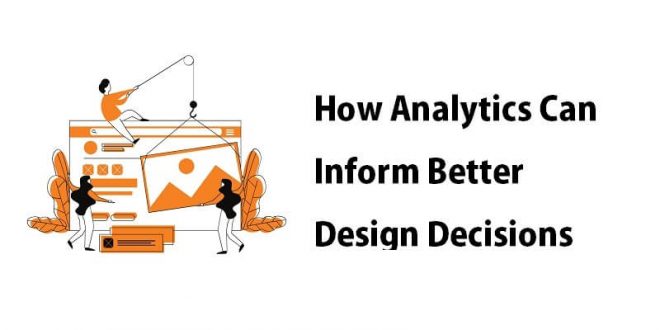In the digital age, where online presence is intertwined with success, understanding and utilizing web analytics has become paramount for web designers and developers. This comprehensive guide explores how analytics can inform better design decisions, leading to more engaging and effective websites.
By integrating strategic insights with practical advice, we’ll navigate through the essentials of web analytics.
How Analytics Can Inform Better Design Decisions:
Understanding Web Analytics
Web analytics is the backbone of digital strategy, offering insights far beyond basic metrics. It delves into the nuances of user engagement, pinpointing where users spend their time and which elements capture their attention. By understanding these intricate details, web developers and marketers can craft experiences that resonate more deeply with their audience. Furthermore, advanced analytics can reveal user paths through a site, identifying potential friction points and opportunities for optimization. This level of detail informs UX enhancements and guides strategic content placement and design improvements, making web analytics a critical tool in the digital toolkit.
Setting Goals and Key Performance Indicators (KPIs)
Setting goals and KPIs is akin to charting a map for your website’s journey. Beyond just increasing traffic, it’s about creating meaningful interactions that lead to a loyal audience or customer base. For instance, analyzing the paths leading to conversions can uncover invaluable insights into user preferences and behavior. This strategic alignment between website objectives and measurable outcomes ensures that every design decision is made with a purpose, enhancing the likelihood of achieving long-term success and making your digital presence not just visible but impactful.
Utilizing Analytics Tools
The landscape of analytics tools extends beyond the mainstream, offering a plethora of options tailored to specific needs. From understanding your audience’s geographic distribution to dissecting your content’s performance across different platforms, these tools can significantly elevate a website’s strategic approach. For designers, integrating analytics into the development process from the start enables a data-driven design philosophy. This approach ensures that websites are aesthetically pleasing and aligned with user needs and behaviors, increasing engagement and satisfaction.
Analyzing User Behavior
Understanding how users interact with your website is pivotal. Analyze metrics like:
- Bounce Rate: The percentage of visitors who navigate away after viewing only one page. A high bounce rate might indicate that your landing pages are not relevant or engaging enough.
- Pageviews and Time on Site: These metrics help gauge content effectiveness and user engagement.
- Conversion Rate: Especially important for e-commerce sites, this measures how well the site turns visitors into customers or leads.
Responsive Design and Loading Speed
Responsive design transcends mere compatibility; it’s about providing an optimal experience across all devices, with loading speed being a critical factor. In an era where patience is limited, the speed at which a site becomes interactive can make or break user engagement. High-speed internet has set the bar high for loading times, making it essential for websites to keep up. This necessitates a design approach that prioritizes aesthetics and the technical aspects of web development, ensuring that sites are agile, responsive, and quick to load.
Making Data-Driven Design Decisions
Armed with analytical insights, it’s time to implement changes to improve UX and achieve your website’s goals. This might involve:
- Redesigning Navigation: Simplifying your site’s navigation based on user flow data can significantly enhance the user experience.
- Optimizing Content: Tailoring content to meet the needs and preferences of your audience, as revealed through analytics.
- Improving Page Load Times: Adjusting images, scripts, and other elements to boost speed, especially critical in an era of high-speed internet expectations.
Testing and Iteration
The journey of website optimization is ongoing, with continuous testing and iteration forming its core. A/B testing, user feedback, and analytics play pivotal roles in this process, offering a feedback loop that fosters constant improvement. This iterative process is not just about refining what exists; it’s about being proactive in anticipating user needs and trends. By staying committed to this cycle of testing, learning, and evolving, websites can remain relevant and engaging, ensuring they meet and exceed user expectations in a rapidly changing digital landscape.
Looking Ahead: The Future of Web Analytics
As technology advances, so too does the field of web analytics. We’re seeing a shift towards more sophisticated metrics, including user sentiment analysis and predictive behavior models. These advancements promise even deeper insights into user behavior, offering new opportunities to refine and personalize the web experience.
In the vast digital landscape, leveraging web analytics for web design is not just advantageous; it’s essential. Web designers can create more engaging, effective, and user-friendly websites by understanding user behavior, setting clear goals, and making informed decisions. As access to high-speed internet becomes the norm, the ability to quickly adapt and optimize based on real-time data will define the successful websites of tomorrow.
This beginner’s guide to leveraging analytics for web design decisions underscores the importance of data in the creative process. By embracing analytics, designers can ensure their websites look good and perform well, meeting the needs of today’s fast-moving online world.
Interesting Related Article: Top 10 Web Design Best Practices for Enhanced User Experience.
 Free Web Resources , psd, mockups, & web templates Best WordPress Themes & Best Html Templates
Free Web Resources , psd, mockups, & web templates Best WordPress Themes & Best Html Templates








